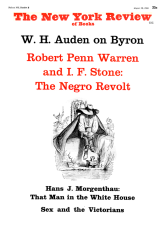In response to:
Stonehenge in Darkness from the June 23, 1966 issue
To the Editors:
In my book Stonehenge Decoded [NYR, June 23] I may have passed on a few archaeological inaccuracies as claimed by your reviewer, R.J.C. Atkinson. I say “passed on” because the archaeological data were taken from the literature which, as Prof. Piggott commented in preparing his new and excellent survey of Ancient Europe, was “often confused and ambiguous, sometimes admittedly conflicting…” We still lack a definitive book on the archaeology of Stonehenge. As it was, the manuscript was read and approved by a competent archaelogist before publication.
It is true that the numerous embanked hill-top areas like Stonehenge I are now regarded as ritualistic places rather than cattle pounds, but this change tends to support the astronomical theory. In the review Atkinson said, “That the layout of Stonehenge has some astronomical significance is not in doubt, for the orientation of the axis of the stones upon the midsummer sunrise has been recognized since the early part of the eighteenth century,” whereas in 1960 concerning the heelstone sunrise he wrote “…it does nothing of the sort.”
Concerning the other alignments, Atkinson states that whereas the probable error is found to be plus or minus 2 degrees, the Stonehengers should have measured to within plus or minus 0.08 degrees in azimuth and plus or minus.05 degrees in elevation. This is almost the resolving power of unaided vision—smaller than a period at normal reading distance. As an astronomer I state that this precision is impossible.
The journalistic style of the book was distasteful to Atkinson who would have preferred a more scholarly account. In fairness he should have mentioned that the original scientific papers are reprinted in full in the Appendix. Incidentally these papers had no criticism since their publication 3 years ago.
The photographs of sunrise and sunset and the photographic plans in my book now take the judgment of the astronomical theory into the hands of the general reader who can examine the evidence and decide for himself.
Gerald S. Hawkins
Chairman Department of Astronomy,
Boston University
R.J.C Atkinson replies:
Professor Hawkins cannot excuse factual inaccuracies by an appeal to the conflicting testimony of the published sources he has used. None of these supports any of the false statements instanced in my review, let alone others which could equally well have been cited.
His reference to cattle-pounds is both obscure and irrelevant. If he had read his sources with attention, he would know that the embanked circles containing rings of pits, which I mentioned as parallels to Stonehenge I, have nothing whatever to do with the hill-top enclosures (“causewayed camps”) which were until recently interpreted as cattle-pounds.
Hawkins persistently confuses the axis of the stone circle with the line of sight from its center to the tip of the Heel Stone. These are not the same, however much he may try, by quoting me out of context, to suggest that I suppose that they are. There is no contradiction between the two statements of mine which he cites. They refer to two different lines of sight, and to two very different dates.
Concerning the alignments, I did not state in my review that “the probable error is found to be plus or minus 2 degrees.” I said, and I repeat, that Hawkins has assumed arbitrarily that errors of this size are acceptable. The sun and moon both have diameters of just over half a degree. As Hawkins’s own photographs show (e.g., his plates 18 and 19), a lateral shift of one-sixth of this amount on the horizon is readily perceptible. Were it true (which it is not, by a long way) that “this is almost the resolving power of unaided vision,” we should be unable to distinguish with the naked eye the detail visible on the surface of the moon.
Finally, it is barely credible that Hawkins should suppose that his photographs can be used as evidence, either for or against his theories; for what a photograph show depends entirely on the viewpoint from which it was taken. Neither of the sunrise photographs cited above was, or could have been, taken either on the axis or from the center of the monument. As evidence, therefore, they are valueless. Their implications for the standards of evidence and logic acceptable to Professor Hawkins is a matter which can confidently be left to the judgment of the reader.
This Issue
August 18, 1966



